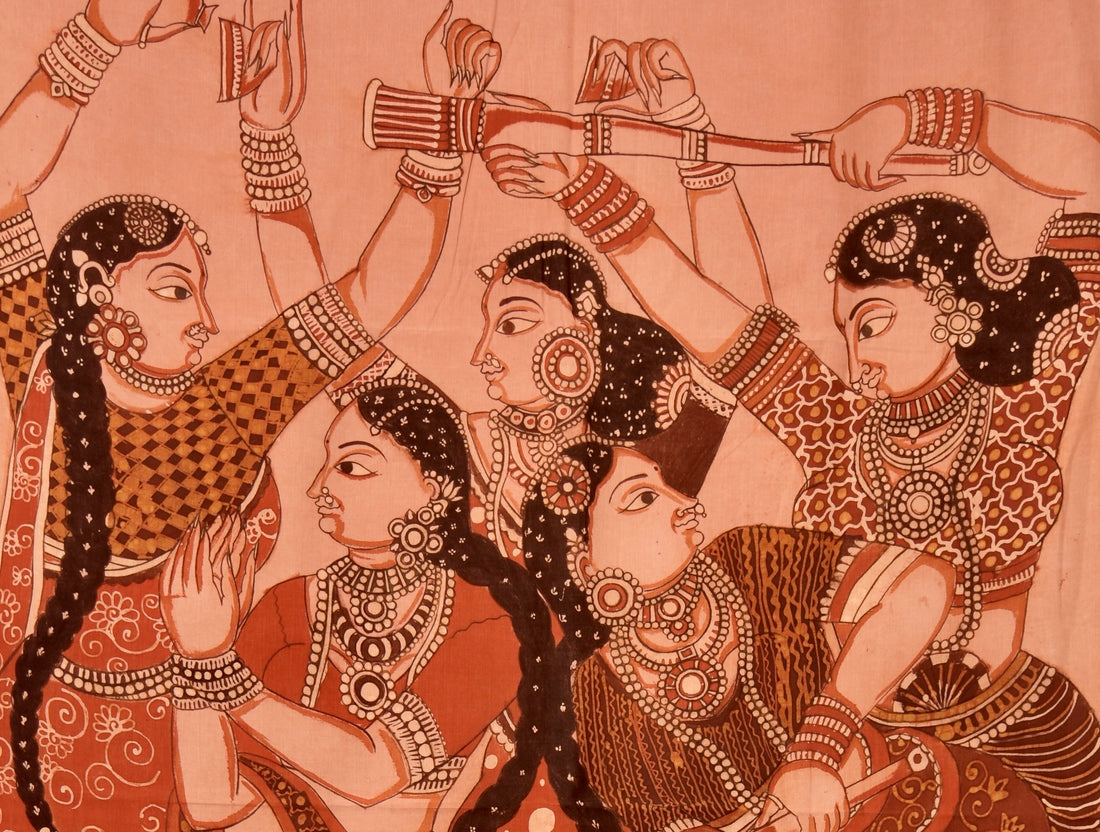
RECREATING NAYAKA KALAMKARIS
Image: Nayaka kalamkari Vasantotsava. Image courtesy of Vipindas
Written by Brinda Gill
“As scholars study hand-painted textiles from India in greater depth, they are further grouping these textiles according to their origin and iconography. In India, hand-painted textiles are broadly known as kalamkari that literally means created by a kalam or pen. These textiles have been internationally known as chintz. Yet under this umbrella of chintz, we now have sub-groups of hand-painted textiles of particular styles” says Vipindas, co-founder, Aksh Weaves And Crafts, a studio in Madras/Chennai, Tamil Nadu state, India.
“Among the more recently identified sub-group of chintz is Nayaka Kalamkari, distinct for their depiction of figures that are more Indian. The foreign influence, on the portrayal of the facial features and attire of the figures, appears minimal. The themes of the compositions are also different. The extant historical Nayaka Kalamkaris feature courtly scenes, palace scenes, the beauty and celebration of life itself and the celebrations of Vasantotsava, a festival celebrating the arrival of spring”. Image: Design and theme development of a Nayaka Kalamkari. Image courtesy of Vipindas
Image: Design and theme development of a Nayaka Kalamkari. Image courtesy of Vipindas
Nayaka Kalamkari takes its name from the Nayakas who were in power (starting from the mid-14th century to 1763) in a part of South India that falls mostly in present day Tamil Nadu. They were great patrons of crafts, arts and architecture. The few surviving hand-painted textiles made under their patronage are now in museums and private collections.
The team at Aksh has been studying and recreating traditional historical textiles of South India. They work with traditional, master artisans. Most recently the Aksh team has worked on recreating Nayaka Kalamkaris with natural mordants and natural dyes to create wall art and saris.
Aksh delved into recreating Nayaka Kalamkaris as they found this sub-group of chintz being lesser known while being high on aesthetics, requiring technical skill to create and being of a distinct character to chintz from other centres like Srikalahasti and Machilipatnam, in the state of Andhra Pradesh, that are well- known. Image: Nayaka kalamkari washing before dyeing.
Image: Nayaka kalamkari washing before dyeing.
Image courtesy of Vipindas
Creating a Nayaka Kalamkari requires several steps. The fabric is scoured, milk and myrobalan (that can act as a mordant and dye) are applied, the cloth smoothened with a stone, the composition sketched with alum and iron (mordants), the fabric is washed and dyed in manjistha (Indian Madder to obtain red colour). The process is then repeated from applying milk and myrobalan while playing with the quantities of mordants and dyes used as well as by using different dyes to obtain different colours. During this process wax resist is also applied to work fine details of the pattern of attire, of jewellery and flowers. Once the work is completed the final result is revealed.
 Image: Nayaka Kalamkari showing Goddess Sita fascinated by Maricha a demon in the form of a beautiful golden deer. Image courtesy of Vipindas
Image: Nayaka Kalamkari showing Goddess Sita fascinated by Maricha a demon in the form of a beautiful golden deer. Image courtesy of Vipindas
“In many ways, Nayaka murals and painted textiles can be seen as the last glimmer of a magnificent flame of art that has since faded. We are happy to work on recreating a glimpse of their ethereal beauty. We hope to continue our work on these beautiful historical textiles”.
